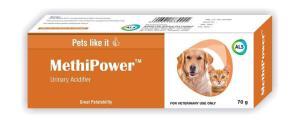Table of Contents
Kidney disease in dogs, or renal disease, occurs when the kidneys are damaged or their function is impaired. This can result in the inability to properly filter waste products, maintain fluid balance, and regulate electrolytes in the body, leading to various symptoms and potential complications.

What Is Chronic Kidney Disease (CKD) or Chronic Renal Failure (СRF) in Dogs?
Chronic kidney disease (CKD) or chronic renal failure (CRF) in dogs refers to a long-term and progressive condition where the kidneys gradually lose their ability to function properly. It is characterized by the irreversible deterioration of kidney tissue over time. CKD can be caused by various factors such as aging, genetic predisposition, infections, toxins, immune disorders, or other underlying diseases. As the disease progresses, the kidneys become less efficient at filtering waste products and regulating fluid and electrolyte balance, leading to a buildup of toxins and imbalances in the body. Symptoms may include increased thirst and urination, weight loss, decreased appetite, lethargy, and changes in urine output. Early diagnosis and appropriate management are crucial to slow the progression of CKD and provide supportive care to maintain the best possible quality of life for affected dogs.
Treating kidney disease in boxers and other dogs is important because it can progress and lead to significant health problems or even be life-threatening if left untreated. Treatment aims to slow the progression of the disease, manage symptoms, and improve the dog’s quality of life. Timely intervention can help preserve kidney function, control blood pressure, manage hydration and electrolyte balance, and address underlying causes or contributing factors to support the dog’s overall well-being.
What Breeds Are Most Likely to Be Affected?
Certain dog breeds are known to have a higher predisposition to develop chronic kidney disease (CKD) than others. Some breeds that are commonly associated with an increased risk of CKD include:
- Cocker Spaniel
- Doberman Pinscher
- German Shepherd
- Golden Retriever
- Labrador Retriever
- Bull Terrier
- Boxer
- Shih Tzu
- Lhasa Apso
- Bullmastiff
While these breeds may be more susceptible to CKD, the condition can affect dogs of any breed or mix. Other factors such as age, overall health, genetics (genetic kidney disease in dogs), and environmental factors can also play a role in the development of CKD. Regular veterinary check-ups and appropriate monitoring are recommended for all dogs, regardless of breed, to detect and manage kidney disease early.
How Many Stages of Renal Failure in Dogs?
Renal failure in dogs is typically classified into four stages based on the severity of kidney dysfunction. These stages are used to assess the progression of the disease and guide treatment decisions. Contact a veterinarian to learn how to treat chronic kidney disease in dogs. The stages of renal failure in dogs are as follows:
Stage 1: Mild renal insufficiency
This stage is characterized by mild kidney damage with minimal clinical signs. Kidney function is still relatively preserved, and the dog may not show obvious symptoms. Early detection and intervention are crucial in this stage to slow the progression of the disease.
Stage 2: Renal insufficiency
In this stage, there is moderate kidney damage, and the dog may begin to show more noticeable signs such as increased thirst, increased urination, and mild weight loss. Medical management and dietary modifications are typically implemented to manage the condition.
Stage 3: Renal failure
How bad is stage 3 kidney disease in dogs? There is significant kidney damage at this stage, resulting in a marked decrease in kidney function. The dog may exhibit more pronounced symptoms such as decreased appetite, weight loss, vomiting, and changes in urine output. Treatment focuses on supportive care, including fluid therapy, medication, and dietary adjustments.
Stage 4: End-stage renal failure
This is the most severe stage of renal failure, where the kidneys are significantly damaged, and their function is severely impaired or non-functional. Clinical signs are severe, and the dog’s quality of life may be greatly affected. Treatment options may include palliative care, such as managing symptoms and providing comfort, but the focus is maintaining the dog’s best possible quality of life.
The progression of renal failure can vary between individual dogs, and not all dogs will progress through all stages.
Causes of Kidney Failure
What can cause kidney disease in dogs? Kidney failure, also known as renal failure, can have various causes in dogs. Some common causes include:
- Geriatric degeneration: As dogs age, their kidneys can undergo degenerative changes, leading to a gradual decline in kidney function. This age-related degeneration can contribute to the development of kidney failure.
- Congenital disease: Some dogs may be born with congenital abnormalities or genetic disorders that affect the structure or function of their kidneys. These conditions can lead to kidney failure at a young age or as the dog matures.
- Bacterial infections: Certain bacterial infections, such as leptospirosis or pyelonephritis, can directly invade the kidneys and cause damage to the renal tissue. If left untreated, these infections can progress to kidney failure.
- Toxicosis: Exposure to certain toxins or chemicals can result in kidney damage and subsequent kidney failure. Common examples include ingestion of antifreeze (ethylene glycol), certain medications (e.g., NSAIDs, certain antibiotics), certain plants (e.g., lilies, grapes/raisins), or exposure to heavy metals (e.g., lead, mercury).
- Immune-mediated diseases: Some immune-mediated diseases, such as immune complex glomerulonephritis, can cause inflammation and damage to the kidney tissues, resulting in renal failure.
These causes further illustrate the diverse range of factors that can contribute to kidney failure in dogs. Identifying the underlying cause is essential for appropriately treating and managing affected dogs.
How Is Chronic Kidney Disease Diagnosed? What Tests Are Needed?
Diagnosing chronic kidney disease (CKD) in dogs typically involves a combination of clinical evaluation, physical examination, and diagnostic tests. Here are some recommendations on how to test for kidney disease in dogs:
1. Blood tests: Blood tests are crucial in evaluating kidney function. The two primary blood tests used are:
- Serum creatinine: Elevated levels of creatinine indicate reduced kidney function. Creatinine is a waste product the kidneys normally filter out of the blood.
- Blood urea nitrogen (BUN): Increased BUN levels can indicate kidney dysfunction. BUN is a waste product that is normally excreted by the kidneys.
- Urinalysis: Urinalysis helps assess the urine for the presence of abnormalities, such as the presence of protein, blood, or abnormal levels of specific substances. It can also provide information about the concentration and dilution ability of the kidneys.
2. Urine protein-to-creatinine ratio (UPC): This test measures the ratio of protein to creatinine in the urine and helps evaluate the extent of protein loss because of kidney disease in dogs, which can indicate kidney damage.
3. Blood pressure measurement: Hypertension (high blood pressure) is common in dogs with CKD. Blood pressure measurement can help assess the impact of CKD on the cardiovascular system.
4. Imaging studies: X-rays or ultrasound may be performed to evaluate the kidneys’ size, shape, and structure. These imaging studies can help identify any abnormalities or changes in the kidneys.
5. Additional tests: In some cases, additional tests may be recommended based on the dog’s specific condition. These can include tests for infectious diseases (such as leptospirosis), specialized blood tests (e.g., electrolyte levels, complete blood count), or a kidney biopsy to assess the extent of kidney damage.
Here’s how to check for kidney disease in dogs. The specific diagnostic approach may vary depending on the individual dog and the veterinarian’s judgment. A thorough evaluation and proper interpretation of the results are crucial for accurately diagnosing chronic kidney disease in dogs.
Symptoms and Signs of Renal Disease & Renal Failure in Dogs
What are the symptoms of kidney disease in dogs?
Dogs’ renal disease and renal failure can manifest through various symptoms and signs. These can vary depending on the stage of the disease and the extent of kidney damage. Here are some common symptoms and signs to look out for:
- Increased thirst (polydipsia) and urination (polyuria): Dogs with renal disease often drink and urinate more frequently than usual due to the kidneys’ inability to concentrate urine properly.
- Decreased appetite and weight loss: Dogs with kidney disease may show a decreased interest in food, resulting in weight loss and malnutrition.
- Lethargy and weakness: Reduced kidney function can lead to a buildup of waste products in the bloodstream, causing dogs to feel tired, weak, and less active.
- Vomiting and diarrhea: Kidney disease can disrupt the normal digestive processes, leading to vomiting and/or black diarrhea in dogs with kidney disease.
- Bad breath and oral ulcers: Dogs with renal disease may develop a distinctive ammonia-like breath odor. They can also develop oral ulcers or sores in the mouth.
- Pale gums: kidney disease causes anemia in dogs; it may result in pale or yellowish gums.
- Changes in urine: The urine may appear more dilute or have an abnormal color (e.g., dark or bloody urine).
- Hypertension (high blood pressure): Dogs with kidney disease may develop hypertension, which can manifest through symptoms such as disorientation, head pressing, or eye bleeding.
- Fluid retention and swelling: In advanced stages of kidney failure, dogs may experience fluid retention, leading to swelling of the limbs or abdomen.
If you notice any skin issues in your dog, ask your veterinarian does kidney disease cause itching in dogs or not.
These symptoms and signs can also be associated with other health conditions, so a proper veterinary evaluation and diagnostic tests are necessary to determine the underlying cause. If you notice any of these symptoms in your dog, it’s recommended to consult a veterinarian for a thorough examination and appropriate diagnosis. They will advise how to cure kidney disease in dogs.

What Are the Prognosis for Renal Failure in Dogs?
The prognosis for kidney disease in dogs (life expectancy) can vary depending on various factors, such as the underlying cause, the stage of kidney failure, the overall health of the dog, and the promptness and effectiveness of treatment. Generally, it is important to note that renal failure is a progressive and often irreversible condition. However, with proper management and supportive care, it is possible to slow down the progression of the disease and provide a good quality of life for affected dogs.
In some cases, if kidney failure is detected early and appropriate interventions are implemented, it may be possible to manage the condition and extend the dog’s lifespan. This can involve dietary modifications, medications to control blood pressure or manage symptoms, fluid therapy to maintain hydration and close monitoring of the dog’s condition.
However, the prognosis becomes more guarded in more advanced stages of renal failure. Dogs may require more intensive management and supportive care, and the goal shifts towards maintaining comfort and quality of life. This can involve measures such as pain management, nutritional support, and addressing specific symptoms or complications that arise.
It’s important to have open and ongoing communication with your veterinarian to understand your dog’s specific prognosis and develop a treatment plan tailored to their needs. Regular monitoring, adherence to recommended treatments, and a supportive and comfortable environment can help optimize the prognosis and enhance the well-being of dogs with renal failure.
How to Prevent Kidney Failure in Dogs
While not all cases of kidney failure in dogs can be prevented, there are several steps you can take to help reduce the risk and promote kidney health.
Feed your dog a high-quality, balanced diet appropriate for their age, breed, and health condition. Consult your veterinarian to determine the best diets for kidney disease in dogs, as some medical conditions may require specific dietary considerations. Ensure your dog has access to fresh, clean water at all times. Proper hydration is important for maintaining kidney function and flushing out toxins.
Schedule regular veterinary check-ups for your dog, including comprehensive physical examinations and blood/urine tests. Early detection of underlying health issues can help prevent or manage conditions contributing to kidney disease.
Keep your dog away from toxic substances, including certain plants, medications (both human and veterinary), household chemicals, and toxic foods (e.g., chocolate, grapes/raisins, onions, garlic). Avoid exposing your dog to harmful chemicals or substances inside and outside the home.
If your dog has underlying health conditions such as diabetes or high blood pressure, work closely with your veterinarian to manage and control these conditions. Proper management can help minimize the risk of kidney damage.
Regular exercise helps maintain overall health and circulation, contributing to optimal kidney function. However, ensure that exercise is appropriate for your dog’s age, breed, and any existing health conditions.
Obesity can strain the kidneys and increase the risk of kidney disease. Ensure your dog maintains a healthy weight through a balanced diet and regular exercise.
Promptly treat and manage urinary tract infections to prevent them from spreading to the kidneys and causing kidney damage.
These measures can help reduce the risk of kidney failure. Some cases may still occur due to factors beyond our control. Regular veterinary care and early intervention remain key to maintaining your dog’s kidney health and overall well-being.
Renal Essentials (Astragalus, Rehmannia Glutinosa, Nettle, Lecitin, L-arginine, Vits B1, B2, B6, B12, Folic Acid), 1mg
Renal Essentials is a kidney disease in dogs natural treatment. It is a supplement formulated for dogs with several active ingredients that support kidney health. Renal Essentials is typically used as a dietary supplement for kidney disease in dogs or as a preventive measure for dogs at risk of developing kidney issues. A veterinarian may recommend it in cases of chronic kidney disease (CKD), kidney insufficiency, or to support kidney health in aging dogs.
Active Ingredients
- Astragalus is an herb that has been traditionally used in Chinese medicine. It is believed to have immune-modulating properties and may help support kidney function.
- Rehmannia is an herb used in traditional Chinese medicine for its potential benefits in supporting kidney and liver health. It is believed to have antioxidant and anti-inflammatory properties.
- Nettle is a plant known for its diuretic properties. It may help promote urine production, which can aid in flushing out toxins from the kidneys.
- Lecithin is a natural compound derived from sources such as soybeans or eggs. It contains phospholipids that can help maintain cell membrane integrity and support cellular health.
- L-arginine is an amino acid that plays a role in the production of nitric oxide, which helps regulate blood flow and may have vasodilatory effects. It is included in Renal Essentials to support circulatory function.
- Vitamins B1, B2, B6, B12, and Folic Acid are essential vitamins that play various roles in overall health and metabolism. They are included in Renal Essentials to support overall well-being and promote the healthy functioning of the kidneys.
How to Take
The dosage and frequency of Renal Essentials may vary depending on the specific product and the dog’s size, age, and health condition. Following the dosage instructions provided on the product label or as your veterinarian directs is important.
Benefits
The combination of active ingredients in Renal Essentials is intended to help support and maintain healthy kidney function. Some ingredients, such as Rehmannia Glutinosa and astragalus, may have antioxidant and anti-inflammatory properties, which can help protect the kidneys from damage. L-arginine and certain vitamins in Renal Essentials may aid in maintaining healthy blood flow and circulation to the kidneys.
Methipower (Dl Methionine) Oral Paste, 70g
Is there treatment for kidney disease in dogs? Yes, MethiPower is a 70g oral paste designed as a urinary acidifier for dogs and cats. Its active ingredient, Methionine, stimulates the taste interest in cats and dogs when a small amount of MethiPower is applied to their nose. This highly palatable and nutritional paste is primarily used to prevent struvite stone formation in the urinary tract. Additionally, it aids in reducing and controlling urine odor. MethiPower provides a convenient and effective way to support urinary health in pets.
Active Ingredient
Methionine is an essential amino acid that plays a vital role in synthesizing proteins and various metabolic processes in the body. The body does not produce it naturally, and must be obtained through the diet. Methionine is involved in forming other important compounds, such as glutathione, and it is known for its acidifying properties in the urine, which can be beneficial in certain urinary conditions.
Benefits
Methipower is commonly used as a urinary acidifier in pets to help prevent the formation of certain types of urinary stones, particularly struvite stones. Methionine can help reduce and control the odor of urine in pets. Methionine-based medications may help maintain the overall health of the urinary tract in pets. Regulating urinary pH and preventing the formation of crystals or stones can support urinary tract function and reduce the risk of related complications.
FAQ
How common is kidney disease in dogs?
Kidney disease is relatively common in dogs, especially in older dogs. According to kidney disease in dogs statistics of 2023, it has been estimated that around 10% of dogs will develop some form of kidney disease during their lifetime.
How fast does kidney disease progress in dogs?
The progression of kidney disease in dogs can vary. Some cases progress slowly over months to years, while others may progress more rapidly. Factors such as the underlying cause, the dog’s overall health, and the effectiveness of treatment play a role in the rate of progression.
Does a high protein diet cause kidney disease in dogs?
Contrary to popular belief, no definitive evidence exists that a high-protein diet directly causes kidney disease in healthy dogs. However, dogs with advanced kidney disease may require a specific dietary approach with controlled protein levels to manage their condition effectively.
How many stages are there in dog kidney disease?
Dog kidney disease is typically classified into four stages: Stage 1 (mild renal insufficiency), Stage 2 (renal insufficiency), Stage 3 (renal failure), and Stage 4 (end-stage renal failure). These stages help assess the severity of the disease and guide treatment decisions.
What causes tremors in dogs with kidney disease?
Tremors in dogs with kidney disease can have various causes. Some possible factors include electrolyte imbalances, uremic toxins affecting the nervous system, or underlying conditions contributing to tremors. A veterinarian should evaluate the dog to determine the specific cause and provide appropriate treatment.
How to stimulate appetite in dogs with kidney disease?
Stimulating appetite in dogs with kidney disease can be challenging, but there are several strategies you can try:
- Offer highly palatable, low-phosphorus foods specifically designed for dogs with kidney disease.
- Warm the food slightly to enhance the aroma and make it more appealing.
- Feed smaller, more frequent meals to prevent overwhelming the dog’s appetite.
- Add low-sodium broth or water to the food to make it more enticing and moist.
- Consult a veterinarian for appetite-stimulating medications or additional nutritional support options.

























